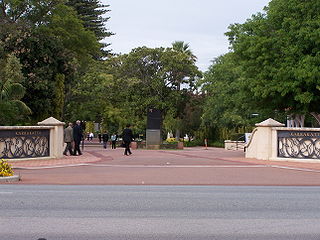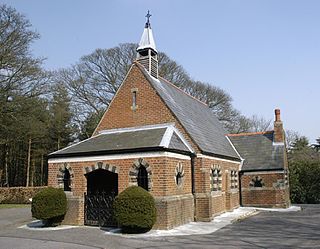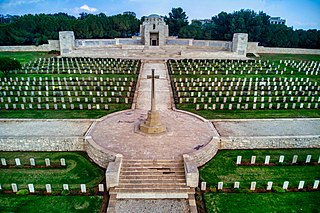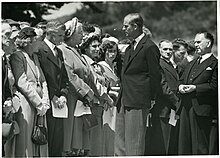
Rookwood Cemetery is a heritage-listed cemetery in Rookwood, Sydney, Australia. It is the largest necropolis in the Southern Hemisphere and is the world's largest remaining operating cemetery from the Victorian era. It is close to Lidcombe railway station about 17 kilometres (11 mi) west of the Sydney central business district. It was added to the New South Wales State Heritage Register on 2 April 1999.

A war grave is a burial place for members of the armed forces or civilians who died during military campaigns or operations.

Karrakatta Cemetery is a metropolitan cemetery in the suburb of Karrakatta in Perth, Western Australia. Karrakatta Cemetery first opened for burials in 1899, the first being that of wheelwright Robert Creighton. Managed by the Metropolitan Cemeteries Board, the cemetery attracts more than one million visitors each year. Cypress trees located near the main entrance are a hallmark of Karrakatta Cemetery. The cemetery contains a crematorium, and in 1995 Western Australia's first mausoleum opened at the site.
Centennial Park Cemetery is a large, 40.5-hectare (100-acre) cemetery in the southern Adelaide suburb of Pasadena, South Australia, located on Goodwood Road. It is the largest cemetery in the southern suburbs and one of the largest in the Adelaide metropolitan area. It is jointly owned by the local government areas of the City of Mitcham and the City of Unley, with a Board of Management that includes two serving councillors from each council.

Aldershot Military Cemetery is a burial ground for military personnel, or ex-military personnel and their families, located in Aldershot Military Town, Hampshire.

The Cannock Chase German Military Cemetery is on Cannock Chase, Staffordshire, England. The cemetery contains nearly 5,000 burials from both the First and Second World War. The burials are mainly German and Austrian nationals with a very small number of Ukrainians.

Brockley and Ladywell Cemeteries were opened within one month of each other in 1858 and are sited on adjacent plots of previously open land. The two component parts are characteristic examples of the first wave of Victorian public cemeteries and are now part of the Brockley Conservation Area.

Harrogate (Stonefall) Cemetery is a Commonwealth War Graves Commission (CWGC) burial ground for the dead of the First World War and Second World War located on the outskirts of Harrogate in North Yorkshire, England.

Southern Cemetery is a large municipal cemetery in Chorlton-cum-Hardy, Manchester, England, 3 miles (4.8 km) south of the city centre. It opened in 1879 and is owned and administered by Manchester City Council. It is the largest municipal cemetery in the United Kingdom and the second largest in Europe.

Andersons Bay Cemetery is a major cemetery in the New Zealand city of Dunedin. It is located 4 kilometres (2.5 mi) to the southeast of the city centre, on a rocky outcrop which forms the inland part of Lawyers Head, a promontory which juts into the Pacific Ocean. The cemetery is bounded on the western and southern sides by Chisholm Park Golf Links, and to the east by steep slopes which descend to the Tomahawk Lagoon. Despite its name, the cemetery is located in the suburb of Tahuna, which lies immediately to the south of the suburb of Andersons Bay, and almost 1 kilometre (0.62 mi) from the former bay itself, at the head of the Otago Harbour.

The English coastal city of Brighton and Hove, made up of the formerly separate Boroughs of Brighton and Hove in East Sussex, has a wide range of cemeteries throughout its urban area. Many were established in the mid-19th century, a time in which the Victorian "cult of death" encouraged extravagant, expensive memorials set in carefully cultivated landscapes which were even recommended as tourist attractions. Some of the largest, such as the Extra Mural Cemetery and the Brighton and Preston Cemetery, were set in particularly impressive natural landscapes. Brighton and Hove City Council, the local authority responsible for public services in the city, manages seven cemeteries, one of which also has the city's main crematorium. An eighth cemetery and a second crematorium are owned by a private company. Many cemeteries are full and no longer accept new burials. The council maintains administrative offices and a mortuary at the Woodvale Cemetery, and employs a coroner and support staff.

The Jerusalem War Cemetery is a British cemetery in Jerusalem for fallen servicemen of the British Commonwealth in the World War I in the Palestine campaign.

Bromley Cemetery is a cemetery in Christchurch, New Zealand. It occupies approximately 10 hectares to the east of the city centre, on the corner of Keighleys Road and Linwood Avenue. The Christchurch City Council maintains and administers the cemetery.

Waikumete Cemetery, originally Waikomiti Cemetery, is New Zealand's largest cemetery. It occupies a site of 108 hectares in Glen Eden, Auckland, and also contains a crematorium in the south-west corner of the cemetery.

The Karori Crematorium and its adjacent chapel are located in Karori Cemetery in the Wellington suburb of Karori. The crematorium was the first such facility in New Zealand, and it opened in 1909. The Karori Crematorium and chapel are registered by the Heritage New Zealand as Category 1 Historic Places, with registration number 1399.

Mortlake Cemetery is a cemetery in Kew in the London Borough of Richmond upon Thames. It is also known as Hammersmith New Cemetery as it provided burials for the then Metropolitan Borough of Hammersmith when Margravine Cemetery was full. The cemetery opened in 1926 and is still in use. It is now managed by Hammersmith and Fulham Council.

Earlham Road Cemetery, Norwich also known as Earlham Cemetery or Norwich Cemetery is a cemetery located in Norwich which was officially opened on 6 March 1856 and covers 34 acres (14 ha). The cemetery is divided into two distinct sites by Farrow Road A140 which runs north–south across the site. To the east of the road is the original 19th century cemetery and to the west of the road lies the 20th century addition. Today, it caters for all faiths with separate burial grounds and chapels for Jews and Catholics and a growing one for Muslims together with two military cemeteries. The 19th century cemetery is designed with an informal garden cemetery layout with winding paths while the remainder is a more formal grid type which was favoured by cemetery designer John Claudius Loudon. Much of the original cemetery is a County Wildlife Site and contains grassland and a wide selection of mature trees.

Cornelian Bay Cemetery is a cemetery in Cornelian Bay, Tasmania, Australia. It is the oldest cemetery in Tasmania that remains in use.

Bournemouth North Cemetery and Bournemouth Crematorium is a municipal cemetery in Bournemouth, England. The cemetery is located between the suburbs of Charminster, Strouden Park and Queen's Park and is owned by Bournemouth, Christchurch and Poole Council.






















